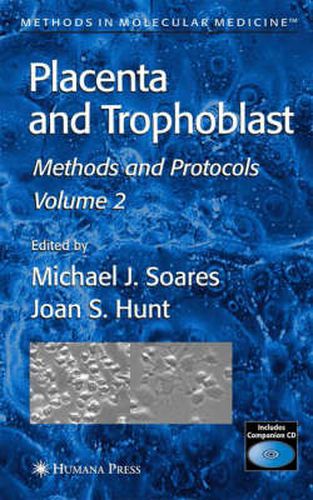Readings Newsletter
Become a Readings Member to make your shopping experience even easier.
Sign in or sign up for free!
You’re not far away from qualifying for FREE standard shipping within Australia
You’ve qualified for FREE standard shipping within Australia
The cart is loading…






This title is printed to order. This book may have been self-published. If so, we cannot guarantee the quality of the content. In the main most books will have gone through the editing process however some may not. We therefore suggest that you be aware of this before ordering this book. If in doubt check either the author or publisher’s details as we are unable to accept any returns unless they are faulty. Please contact us if you have any questions.
The aim of the two-volume set of Placenta and Trophoblast: Methods and Protocols is to offer contemporary approaches for studying the biology of the placenta. The chapters contained herein also address critical features of the female organ within which the embryo is housed, the uterus, and some aspects of the embryo-fetus itself, particularly those of common experimental animal models. In keeping with the organization used effectively in other volumes in this series, each chapter has a brief introduction followed by a list of required items, protocols, and notes designed to help the reader perform the expe- ments without difficulty. In both volumes, sources of supplies are given and illustrations highlight particular techniques as well as expected outcomes. A key aspect of these volumes is that the contributors are at the forefronts of their disciplines, thus ensuring the accuracy and usefulness of the chapters. Placenta research has progressed rapidly over the past several decades by taking advantage of the technical advances made in other fields. For example, the reader will note that many techniques, such as reverse transcriptase po- merase chain reaction, northern and western blotting, microarray analyses and in situ hybridization experiments, are routinely used for dissecting a wide range of experimental questions. Protein analysis and functional experiments on tissues and cells that comprise the maternal-fetal interface benefit from studies in en- crinology, immunology, and developmental biology. These volumes also present new ideas on investigating gene imprinting and gene transfer via viral vectors.
$9.00 standard shipping within Australia
FREE standard shipping within Australia for orders over $100.00
Express & International shipping calculated at checkout
This title is printed to order. This book may have been self-published. If so, we cannot guarantee the quality of the content. In the main most books will have gone through the editing process however some may not. We therefore suggest that you be aware of this before ordering this book. If in doubt check either the author or publisher’s details as we are unable to accept any returns unless they are faulty. Please contact us if you have any questions.
The aim of the two-volume set of Placenta and Trophoblast: Methods and Protocols is to offer contemporary approaches for studying the biology of the placenta. The chapters contained herein also address critical features of the female organ within which the embryo is housed, the uterus, and some aspects of the embryo-fetus itself, particularly those of common experimental animal models. In keeping with the organization used effectively in other volumes in this series, each chapter has a brief introduction followed by a list of required items, protocols, and notes designed to help the reader perform the expe- ments without difficulty. In both volumes, sources of supplies are given and illustrations highlight particular techniques as well as expected outcomes. A key aspect of these volumes is that the contributors are at the forefronts of their disciplines, thus ensuring the accuracy and usefulness of the chapters. Placenta research has progressed rapidly over the past several decades by taking advantage of the technical advances made in other fields. For example, the reader will note that many techniques, such as reverse transcriptase po- merase chain reaction, northern and western blotting, microarray analyses and in situ hybridization experiments, are routinely used for dissecting a wide range of experimental questions. Protein analysis and functional experiments on tissues and cells that comprise the maternal-fetal interface benefit from studies in en- crinology, immunology, and developmental biology. These volumes also present new ideas on investigating gene imprinting and gene transfer via viral vectors.